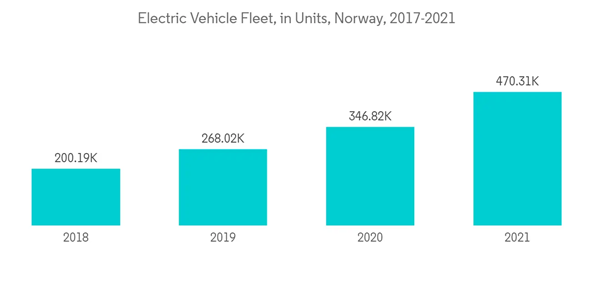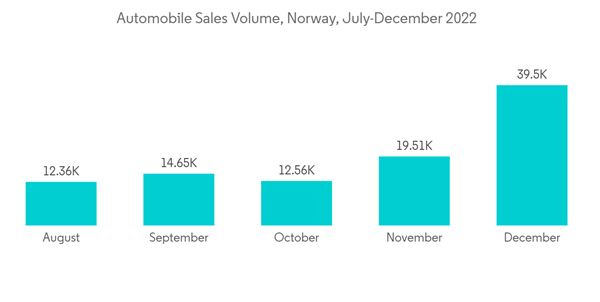The automotive supply industry was impacted by the COVID-19 crisis, as both the production and sales of motor vehicles came to a sudden halt. These work stoppages led to a loss in the production of millions of vehicles worldwide. The market recovered during 2021, with the operation of automotive, power, and other business. According to Statnett, Norway's power demand is expected to increase by 60% to 220 terawatt hours (TWh) by 2050 due to decarbonization efforts and the establishment of new electricity-intensive industries.
Key Highlights
- In the short term, the growing applications in the automobile and transportation industry and the rapid growth in the power generation sector have driven the lubricants market in Norway.
- Also, Norway's net zero ambitions will add 40-60 TWh of additional electricity demand. It is expected to drive market growth during the forecast period.
- Norway's automobile industry mainly comprises electric vehicles. The country's efforts towards complete electrification are a hindrance to the conventional engine oil and other IC engine lubricants market.
- Increasing research and adoption of biofuels is projected to act as an opportunity for the market in the future.
Norway Lubricants Market Trends
Transmission and Gear Oils Segments to Dominate the Market
- Transmission oil is essential for protecting and cleaning the surface and extending the temperature range. It improves cooling, raises rotational speed, conditions the gasket, and lowers high temperatures. They transfer energy, lubricate, and ensure smooth transmission in agricultural equipment, motor vehicles, construction equipment, and mining equipment.
- Power generation, transportation, the oil and gas industry, rubber and plastic manufacturing, agriculture, mining, and construction are all end markets for gear oil.
- The gear oils in the transportation sector include axle oil, manual transmission fluids, and API lubricants. Axle oils are designed for various vehicles, such as commercial trucks and passenger cars. It is also used in agriculture, mining, and construction equipment.
- Further, industrial gear oils are used in metallurgy, metalworking, food processing, power, mining, and oil and gas.
- Norway is a major power exporter in Europe. According to NVE (Norwegian Water Resources and Energy Directorate) data, hydropower accounts for roughly 90% of Norway's electricity supply, with onshore wind accounting for 7%. According to Statnett, total power generation in 2021 was 157 TWh.
- Total power generation figures are estimated to be 158 TWh, roughly 20 TWh more than domestic consumption in 2022, and demand is expected to rise faster than new capacity in the coming years.
- Eight out of ten people choosing fully electric vehicles over combustion engines is a significant step toward Norway's climate goal of 100% BEV sales by 2025.
- BEVs now account for 20.9% of all passenger cars in Norway, and charging infrastructure is keeping pace. In 2022 alone, 1,500 new fast chargers were established, with over 5,600 fast chargers nationwide.
- All the factors above are expected to increase the demand for transmission and gear oils during the forecast period.
Automotive Segment is Expected to Dominate the Market
- Lubricants are used in various applications in the automotive industry, including engine, brake systems, fuel systems, transmission manufacturing, steering systems, exhaust systems, and many others. Automobile lubricants reduce friction by forming a thin layer or film (clearance) between the moving parts. Some of the benefits include shock absorption during heavy loads and contaminant absorption.
- Lubricants are used in marine transportation to dissipate heat, reduce friction, and combat wear and tear between two moving surfaces. Lubricants also aid in the prevention of corrosion and rust in engines, whether they are in an airplane or a car.
- Due to the rapid growth in the country's sales of motor vehicles (both locally built and imported), demand for lubricants is constantly increasing.
- Automobile sales in Norway nearly doubled in December 2022 compared to December 2021, according to OFV (Opplysningsrdet for veitrafikken). Automobile sales in December 2022 were 39,497 units, up from 20,567 in December 2021.
- Tesla, Volkswagen, BMW, Toyota, and Volvo accounted for most automotive sales in the passenger car segment. From January to December 2022, the manufacturers above' sales share was nearly 50% of the total market.
- Norway is long recognized as a global leader in the electric vehicle revolution. Norway had new sales records for battery electric vehicles for over a decade. 2022 was no exception, with the EV market share increasing from 64.5% in 2021 to 79.3% in 2022.
- Owing to all the above factors, the demand for lubricants is expected to grow at a moderate rate during the forecast period.
Norway Lubricants Market Competitor Analysis
The Norway lubricants market is partially consolidated, with a few major players dominating the market. Some major companies (not in any particular order) are Shell PLC, BP PLC, TotalEnergies SE, ExxonMobil Corporation, and FUCHS, among others.Additional benefits of purchasing the report:
- The market estimate (ME) sheet in Excel format
- 3 months of analyst support
This product will be delivered within 2 business days.
Table of Contents
1 INTRODUCTION1.1 Study Assumptions
1.2 Scope of the Study
2 RESEARCH METHODOLOGY
3 EXECUTIVE SUMMARY
4 MARKET DYNAMICS
4.1 Drivers
4.1.1 Growing Demand for Lubricants from the Automotive Industry
4.1.2 Increasing Power Generation Projects
4.2 Restraints
4.2.1 Increasing Adoption of Electric Vehicles to limit Market Growth
4.3 Industry Value Chain Analysis
4.4 Porter's Five Forces Analysis
4.4.1 Bargaining Power of Suppliers
4.4.2 Bargaining Power of Buyers
4.4.3 Threat of New Entrants
4.4.4 Threat of Substitute Products
4.4.5 Degree of Competition
5 MARKET SEGMENTATION (Market Size in Volume)
5.1 By Product Type
5.1.1 Engine Oil
5.1.2 Transmission and Gear Oil
5.1.3 Hydraulic Fluids
5.1.4 Metalworking Fluids
5.1.5 Greases
5.1.6 Other Product Types
5.2 By End-user Industry
5.2.1 Power Generation
5.2.2 Automotive
5.2.3 Heavy Equipment
5.2.4 Metallurgy and Metalworking
5.2.5 Other End-user Industries
6 COMPETITIVE LANDSCAPE
6.1 Mergers, Acquisitions, Joint Ventures, Collaborations, and Agreements
6.2 Market Share (%) **/ Ranking Analysis
6.3 Strategies Adopted by Leading Players
6.4 Company Profiles
6.4.1 BP PLC (Castrol)
6.4.2 Champion Lubricants
6.4.3 Chevron Corporation
6.4.4 ExxonMobil Corporation
6.4.5 FUCHS
6.4.6 Gulf Oil International
6.4.7 Motul
6.4.8 PETRONAS Lubricants International
6.4.9 Shell PLC
6.4.10 TotalEnergies SE
6.4.11 Valvoline Inc.
7 MARKET OPPORTUNITIES AND FUTURE TRENDS
7.1 Increasing Prospects for Bio-based Lubricants
Companies Mentioned (Partial List)
A selection of companies mentioned in this report includes, but is not limited to:
- BP PLC (Castrol)
- Champion Lubricants
- Chevron Corporation
- ExxonMobil Corporation
- FUCHS
- Gulf Oil International
- Motul
- PETRONAS Lubricants International
- Shell PLC
- TotalEnergies SE
- Valvoline Inc.










